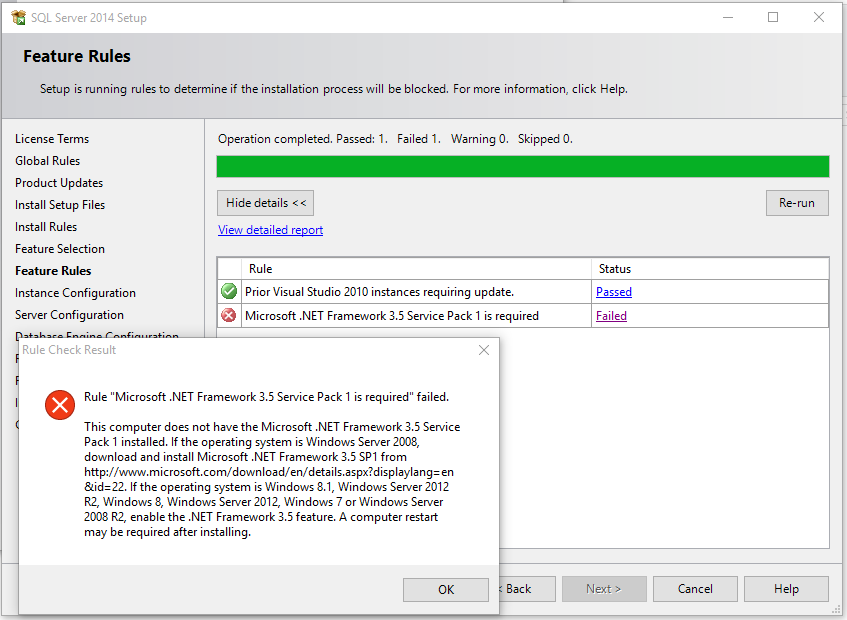
- #Install sql server 2014 free how to#
- #Install sql server 2014 free install#
- #Install sql server 2014 free upgrade#
- #Install sql server 2014 free full#
- #Install sql server 2014 free software#
(Prior to this, AG version upgrades are absolutely terrible, and you’re often better off building a new cluster and migrating over to it.)
#Install sql server 2014 free upgrade#
DAGs aren’t too robust or well-documented today, but I like the idea of this as a down payment on easier upgrades when you upgrade down the road.
You want easier future upgrades – because starting with 2017, you can have a Distributed Availability Group with different versions of SQL Server in it. You have a zero-RPO goal and financial risks – because 2017 added a new minimum commit replica setting on AGs that will let you guarantee commits were received by multiple replicas. (Remember, there are no more Service Packs, just Cumulative Updates.) You’re willing to apply patches every 30-60 days – because on newer releases like this, the patches are coming fast and furious, and they fix some pretty significant issues, and it’s going to be a while before 2019 comes out and 2017’s patches slow down. #Install sql server 2014 free full#
People aren’t using it as much as I’d like. If I took a full time DBA job again tomorrow, this (and PowerShell) would be the two skills I’d probably pick up.
You need query plan monitoring, and you can’t afford a third party tool – because Query Store gives you some pretty cool capabilities. This grid has a great comparison of what changed with columnstore over the years. You want to use columnstore indexes – I’m going to call this the minimum version I’d start with because they were finally updatable and could have both columnstore and rowstore indexes on the same table. You have compliance needs for a new application – And I’m specifically calling out new apps here, but 2016 adds Always Encrypted, Dynamic Data Masking, Row Level Security, and temporal tables, features which make it easier for you to build things to protect and track your valuable data. #Install sql server 2014 free install#
You want to stay here until 2025-2026 – this version has more years left in its support life than SQL Server 2012/2014, so you can install it once and stick around longer. You use Standard Edition – because it supports 128GB RAM (and can even go beyond that for some internal stuff like query plans.). #Install sql server 2014 free how to#
You want an extremely well-known, well-documented product – it’s pretty easy to find material off the shelf and hire people who know how to use the tools in this version.This meant you could write one version of your application that worked at both your small clients on Standard, and your big clients on Enterprise.

#Install sql server 2014 free software#
You’re an independent software vendor (ISV) – because 2016 Service Pack 1 gave you a lot of Enterprise features in Standard Edition.You still have to put in time to find the queries that are gonna get slower, and figure out how to mitigate those.Ģ014 also introduced a few other features that don’t sound like assets today: In-Memory OLTP, which wasn’t production-quality at the time, Buffer Pool Extensions, data files in Azure blobs, backing up to a URL, and Delayed Durability. You need faster performance without changing the code, and you have lots of time to put into testing – 2014’s Cardinality Estimator (CE) changes made for different execution plans, but they’re not across-the-board better.You use log shipping as a reporting tool, and you have tricky permissions requirements (because they added new server-level roles that make this easier.).You need to encrypt your backups, and you’re not willing to buy a third party backup tool.I’d just consider this a minimum starting point for even considering AGs (forget 2012) because starting with 2014, the secondary is readable even when the primary is down. You want to use Always On Availability Groups – but I’m even hesitant to put that here, because they continue to get dramatically better in subsequent versions.
 You’re dealing with an application whose newest supported version is only SQL Server 2014, but not 2016 or newer.
You’re dealing with an application whose newest supported version is only SQL Server 2014, but not 2016 or newer. 
In all, I just can’t recommend 2012 new installs today.
You either don’t need robust encryption for your backups, or you’re willing to buy a third party tool to get it.Ģ012 introduced a few other features – Availability Groups, columnstore indexes, contained databases, Data Quality Services – but they were so limited that it’s hard to consider this a good starting point for those features today. You’re comfortable being out of support (because support ends in July 2022.). You’re dealing with an application whose newest supported version is only SQL Server 2012, but not 2014 or newer. But I got a really good deal on this CD at a garage sale You should consider SQL Server 2012 if… I’m going to go from the dark ages forward, making a sales pitch for each newer version. I know, management wants you to stay on an older build, and the vendor says they’ll only support older versions, but now’s your chance to make your case for a newer version – and I’m gonna help you do it. Are you sure you’re using the right version? Wait! Before you install that next SQL Server, hold up.







 0 kommentar(er)
0 kommentar(er)
